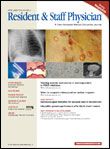Dextrocardia: Precordial Leads Reveal the Diagnosis
To the Editor:
The Picture Perfect article entitled "An Intriguing Electrocardiogram"by Dr K. N. Modii (September 2005) requires comment and correction. The author states that the clinical diagnosis of dextrocardia was made only after a review of the associated imaging study. In fact, the electrocardiogram (ECG) itself provides the answer. The limb leads reveal right axis deviation based on the QRS complexes with a net positive complex in aVR, a hallmark of either limb lead reversal or dextrocardia. The key to the correct diagnosis lies in the interpretation of the precordial leads. When limb leads are reversed, namely the right and left arms are reversed, the precordial leads will show the normal R-wave progression. In this particular case, a decreasing amplitude was found, indicating dextrocardia.1
I complement the author's recognition of the interesting ECG, but disagree with the conclusion that the "chest film was the key to the correct electrocardiographic diagnosis."This can be made from the ECG alone. In addition, a negative P wave in lead I (as indicated in that case) implies dextrocardia with situs inversus, although this usually requires confirmation by viewing the other organs, such as recognition of the right-sided gastric bubble on the chest radiograph.
The informative article by Dr D. R. Coffman, "Dextrocardia with Situs Inversus: A Complex Congenital Anomaly,"in the same issue, details the embryology of dextrocardia, but it also misses the opportunity to clarify the role of ECG findings in this disorder. In addition to being clinically relevant, this is a common electrocardiographic pattern in testing situations.
Melissa Robinson, MD
Fellow, Division of Cardiology
Department of Internal Medicine
University of California at Davis, Sacramento
Practical Electrocardiography
1. The heart in childhood and congenital lesions. In: Marriott HJL, ed. . 8th ed. Baltimore, Md: Williams & Wilkins; 1988:497-498.
